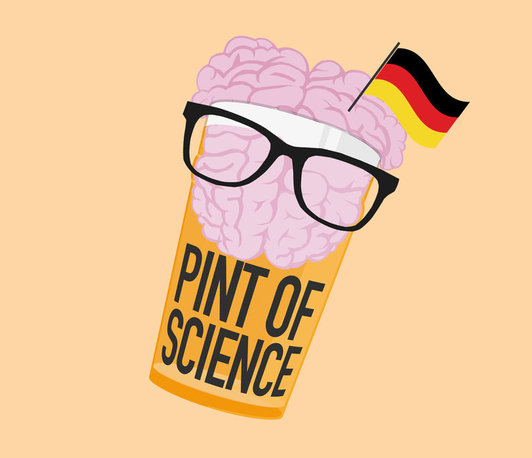Pint of Science
- Datum: 22.05.2023
- Uhrzeit: 19:00 - 22:00
- Vortragende: Laura Merx, Christoph Ringkamp, Philipp Katzy, Sadig Niftullayev
- Ort: Liebefeld zu Ehren, Stammstr. 2a, 50823 Cologne

Pint of science - Day 1
About life - of crystals, bacteria, plants and yeast
Talks of the evening
How bacteria can help us feed the world
Laura Merx (Graduate Student at CEPLAS - Cluster of Excellence on Plant Sciences)
Corn is an essential food crop that is very important all around the world. To grow it, farmers need soil that has lots of nutrients, like nitrogen. But plants can't use atmospheric nitrogen, so they either get it from the soil on their own or they benefit from microorganisms like bacteria. In this talk, we will learn about how microorganisms can help plants grow by providing them with nitrogen. We will also discuss how scientists study these microorganisms and their interactions with plants, so we can better understand how they work together to help our food grow.
The secret life of crystals
Christoph Ringkamp (PhD student in solid state physics at Forschungszentrum Jülich)
Creating single crystals is a crucial process for many of the devices we use every day, such as LED lights, computers, and even quantum computers. Scientists use controlled evaporation of different elements to grow these materials, so small amounts of atoms coalesce into a well-defined crystal onto a surface. By doing this, they can create new materials with exciting properties that work on the quantum scale. Using X-ray diffraction and various microscopy methods, scientists can see the arrangement of atoms on a very small scale, as small as a nanometer or a micrometer.
The daily portion of Aspirin – Plant immunity and Painkiller
Philipp Katzy (PhD student in Plant Sciences at the University of Cologne)
The precursor of Aspirin is Salicylic acid. This chemical is found in plants and helps them to fight off diseases caused by fungi, bacteria, and viruses by activating the plant's immune system which includes changes in gene expression and production of special molecules that help fight off the harmful invaders. Interestingly, the same chemical that helps plants to defend themselves can also relieve pain in humans. In fact, salicylic acid was first extracted from willow bark in the early 1800s and eventually turned into a medicine we know today as aspirin.
How to study the life of a cell with yeast
Sadig Niftullayev (PhD student at Langer Department of the Max Planck Institute for Biology of Ageing)
Organisms of different compexity have been beneficial in studying human biology - one of them being yeast. Familiar to us from baking to beer brewery, yeast is host to some fundamental biological processes that are very similar to higher organism like humans. Not only is yeast a simpler organism to work with, but it is also convenient to maintain and manipulate compared to other animals commonly used in scientific research. In my talk, I will show an example of biological research using yeast as a model organism and use everyday analogies to relate the essence of this research to the audience.